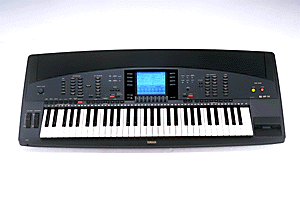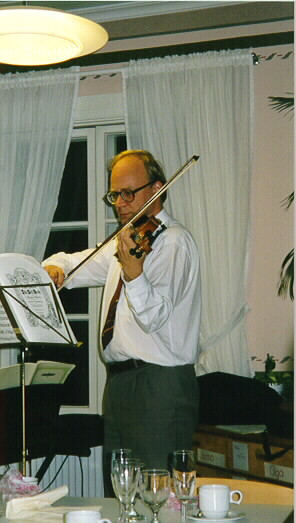


For already some time, I have dreamed of bringing these two aspects of my interests more closely together. Now, since late 1996, I have started to realise this. So, very briefly, I have invested in the quite wonderful gadget shown above, the Yamaha PRS4000 keyboard. I've also bought the Cubasis software for my Macintosh for elementary sequencing and notation, and also tried out the impressive MidiGraphy shareware sequencing program.
Equipped with these tools, I have started to climb the learning curve on MIDI technology and how music may be made with it. I am still quite astonished at just how rich this subject is. It is great fun, and I am sorry I didn't start earlier. More, the Net of Nets has tons of information and samples of MIDI.
The following files give examples of the fruits of my labor so far; in the future others may be coming.
Joseph-Hector Fiocco (1703-1741): Allegro
This small violin piece is presently used as educational material; I midified it because my then 10-year old son Lauri was playing it at the time. In the MIDI file, I tried to mimic the phrasing and bowing of the violin part by more or less careful editing.
Jean Sibelius (1865-1957): Symphony No. 2 D major, Part I (Allegretto)
This is a somewhat more bold attempt to create reasonable sound out of MIDI. To get something like pleasing phrasing , I actually played most parts. Throughout, MIDI velocity is mainly used for dynamic effects. Volume control is used to create the typical Sibelian brass effects, and also some other diminuendos. I left some parts non-quantized to create a somewhat more lively feeling. The result is sort of satisfactory, although there are a couple of spots which are too much for my keyboard's synth to handle. Obviously, there is no limit to just how much attention should be spent on the details of voice balance, articulation, and tempi.
Gustav Mahler (1860-1911): Lieder eines fahrenden Gesellen N:o 1: Wenn mein Schatz Hochzeit macht
Gustav Mahler (1860-1911): Lieder eines fahrenden Gesellen N:o 2: Ging heut' Morgen übers Feld
Gustav Mahler (1860-1911): Lieder eines fahrenden Gesellen N:o 3: Ich hab' ein glühend Messer
Gustav Mahler (1860-1911): Lieder eines fahrenden Gesellen N:o 4: Die zwei blauen Augen
I have liked Mahler's cycle of four songs "Lieder eines fahrenden Gesellen" since I was introduced to them in the record club of my gymnasium at the tender age of 14 or so by my then-schoolmate Esa-Pekka Salonen, who was 11. The mood of the music have fit pretty well my then-sentiments. Mahler must have liked the songs too, for he used to material in his later first symphony.
I learned something while midifying Sibelius. As the result, the material has many more tracks now. I think Mahler's music sequences pretty well: the sound field is intended to be clear and crisp, like chamber music for a big orchestra. It's interesting to think that these songs were originally composed (for voice and piano) pretty much simultaneously with late Brahms. They must have sounded very modern indeed to contemporaries. Studying the score reveals that Mahler was experimenting with fourth harmonies years before Skrjabine or the French impressionists.
I'm afraid that I am not quite satisfied yet with the first song - it needs more work to make the strings sound good. The others are better, and I am not sure that I can improve them much with reasonable efforts.
For all would-be Fischer-Dieskaus there, the files are in Karaoke form.